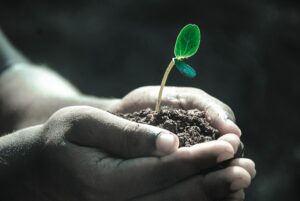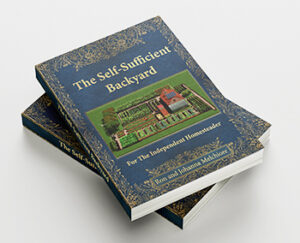Introduction

Homesteading is a great way to begin to practice living self-sufficiently. It can be an empowering experience, and it allows you to be completely in control of your life and environment. This guide will provide you with some helpful tips on how to get started homesteading, including what type of land to look for, building considerations, and various other aspects of self-sufficiency.
Making the Decision to Homestead
Before you can begin creating your homestead, it is important to make sure that you are ready to take on this major life change. There are a lot of decisions to make, and you should be prepared for all the work that comes with owning land and running a home autonomously. It’s important to consider if it is something that you are passionate about, and if you’re willing to put in the effort.
Homestead in Place
Keep in mind, while most people think of homesteading as a move to a piece of land to raise large gardens and livestock, you can homestead right where you are in an apartment, or suburban neighborhood. My definition of homesteading is any attempt to become more self-sufficient regarding your food supply or water source, learning skills that make you more self- sufficient, and trying to go more green in your power to free yourself from dependency on a grid that is more overwhelmed each day and a food supply that is more toxic and suffering supply woes.
Benefits of Living Self Sufficiently
Standard benefits: – Reduce your reliance on external sources for food, energy and other resources. – Become more self-reliant and independent. Emotional benefits: – Connect with nature in a meaningful way. – Enjoy the satisfaction of providing for yourself and your family. Financial benefits: – Reduce your grocery bills. – Save money on energy bills by relying on renewable energy sources such as solar power, wind or water turbines. – Become more financially independent and secure in the long term. Health benefits: – Eat healthier by growing your own organic vegetables and fruits. – Get more exercise through activities such as gardening and animal husbandry. – Spend more time outdoors in the fresh air and sunshine for an improved sense of wellbeing. Environmental benefits: – Reduce your carbon footprint by consuming fewer resources from the environment. – Help to conserve natural habitats and protect ecosystems by using sustainable farming methods. Social benefits: – Create a stronger sense of community and connection with your neighbors by sharing resources. – Learn more about the skills needed to live off the land from seasoned homesteaders. – Pass down valuable skills and knowledge to future generations. Living self-sufficiently is as much a lifestyle choice as it is an achievable goal, but with commitment and dedication, anyone can become a successful homesteader. With the right plan in place, you can reap the many benefits of living self-sufficiently and create a better life for yourself and your family.
Finding the Right Land
When choosing a piece of land, there are some key factors to consider. Location is an important factor, as you will need access to resources such as water and electricity (if desired). You should also consider the climate and soil quality of the land, as this could affect what types of crops you can grow. Additionally, you will need to make sure that the land is zoned for homesteading (if using a residential property). You could also consider finding ways to be more self-sufficient right where you are. This would give you the chance to see if you like gardening or dealing with say chickens or rabbits before committing to the lifestyle. When we bought the land we have today homesteading per se was not on our minds. We wanted a fairly secluded place by water, that was wooded. Now that we are trying to plant a small orchard we have to consider in many places our land is more rock than dirt. One answer for my garden has been raised beds. over the portions that are bedrock but because it is slanted land we had to build a gravel bed to sit the beds on. Just things to consider.
Exploring Sustainable Building Practices
Exploring Sustainable Building Practices is essential for creating a self-sufficient home. Sustainable building practices include but are not limited to: – Building with hay bales: Hay bale construction is an affordable, eco-friendly way to build a home. The straw inside the bales acts as an insulation layer and helps keep your home cool in the summer and warm in the winter.
– Cob Construction: Cob construction uses a mixture of clay, sand, straw, and water to create sturdy walls that are highly durable and energy-efficient. – Straw Bale Construction: Similar to building with hay bales, straw bale construction is an affordable way to build a home that is environmentally friendly. The straw inside the bales acts as an insulation layer and helps keep your home cool in the summer and warm in the winter. This is covered with plaster made of stucco, gypsum or cement. – Earthships: Earthships are homes that are partially or entirely made from recycled materials such as earth-filled used tires. They are designed to be energy efficient and sustainable. They may be partially covered by soil, and collect water from roof runoff into collection tanks. They were designed for desert environments and can keep the home at a steady 70 degrees. – Green Roofs: A green roof is a rooftop covered with vegetation that helps to insulate the home from extreme temperatures. This type of roof also helps to reduce stormwater runoff and improve air quality. – Passive Solar Design: This type of design involves orienting the home in such a way that it collects solar energy from the sun, which can be used to heat the home during winter months.
– Rainwater Harvesting: Rainwater harvesting is a sustainable practice that captures rainwater on the roof of a building and stores it for later use. This water can then be used to irrigate plants, flush toilets, and more.
– Recycled Building Materials: Using recycled materials such as wood, metal, stone, brick, glass, and plastic to build homes is an eco-friendly way to save natural resources while also reducing waste in landfills.
Alternative housing
Alternative housing is housing such as tiny houses, shipping container homes, yurts, and more. These types of homes are often smaller than traditional homes but still offer a comfortable living space that is perfect for those looking to downsize or go off-grid! Tiny houses can be built on trailers so they can easily be moved from place to place. They use fewer materials in their construction and are highly energy efficient. Shipping container homes are made from recycled shipping containers and are an affordable and eco-friendly way to build a home. Yurts offer a unique living space with round walls that provide insulation against extreme temperatures. They are also lightweight, making them easy to move around if needed. These are just some of the different types of eco-friendly housing that you can choose from. There are many more options out there that can help you create a green and sustainable living space that is good for the environment! Personally, I admit, at 65 I wanted nothing to do with building my own house and I needed to consider what my needs would be as I aged. If I had been younger though I very well might have tried some of these options. As it is, I want to try my hand at a straw bale outbuilding!
Utilizing Renewable Energy Sources for Your Home
Utilizing Renewable Energy Sources for Your Home is a great way to reduce your carbon footprint and move towards a more sustainable lifestyle. Renewable energy sources like solar, wind, and geothermal can be used in combination with other forms of energy production to provide electricity or heat for your home. Solar panels are becoming increasingly popular as they are often cheaper than traditional electricity sources. Wind turbines can also be used to generate electricity from the wind and geothermal energy can be used to heat water or air in your home. Taking advantage of renewable energy sources is a great way to reduce your environmental impact and save money on your utility bills. All of these things have expensive upfront costs but if you can do some of it yourself you can save a ton of money. You can find lots of Youtube videos on solar and a plethora of how-to books. Investing in insulation for your home is another great way to make it more eco-friendly. Upgrading insulation can help keep your home cooler in the summer and warmer in the winter, reducing your energy bills and improving your comfort. There are different types of insulation to consider such as spray foam, cellulose, fiberglass, and rock wool. Each type has its own advantages and disadvantages so it’s important to research which one is best for your situation before making a decision. For more on alternative energy click here.

Sustainable Landscaping
Sustainable landscaping involves choosing native plants and trees that are adapted to the local climate and using natural materials on pathways, fences, and other outdoor structures. This helps to reduce water usage while also supporting wildlife habitat. Rainwater harvesting is another way to ne more sustainable. To learn more about rainwater harvesting check out my article here. Composting is a part of sustainable landscaping. Your yard waste and kitchen scraps can be renewable compost for your garden and it can be done wherever you live. If you are interested in composting check out my articles on composting.
Conclusion
Homesteading is all about creating a sustainable lifestyle and living off the land. It requires an investment of time, money, and effort but it can be very rewarding. By taking advantage of renewable energy sources, investing in insulation, and creating a sustainable landscape you can reduce your environmental impact while also saving money. With some hard work and dedication, you can create a homestead that is both eco-friendly and beautiful. Good luck! You might want to check out this book. I love this series. You’ll probably recognize the publisher. I have all thier books and find them full of good information.

